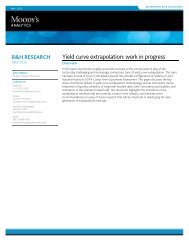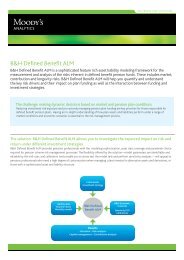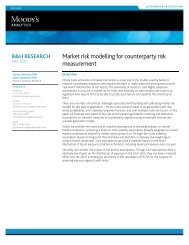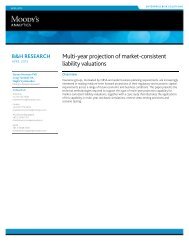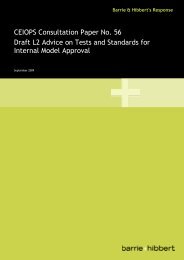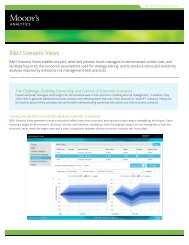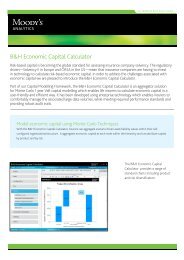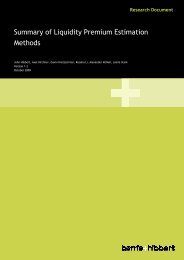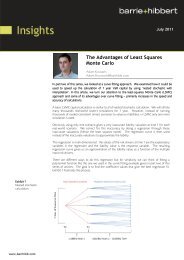Quantifying tail dependency - Barrie & Hibbert
Quantifying tail dependency - Barrie & Hibbert
Quantifying tail dependency - Barrie & Hibbert
You also want an ePaper? Increase the reach of your titles
YUMPU automatically turns print PDFs into web optimized ePapers that Google loves.
Risk aggregation: generalising <strong>dependency</strong><br />
Relationships in the <strong>Barrie</strong> & <strong>Hibbert</strong> ESG<br />
Steven Morrison PhD<br />
September 2010<br />
01<br />
Global insurance risk management report<br />
www.barrhibb.com Page
Contents<br />
Introduction ...................................................................................................... 3<br />
Dependency in the <strong>Barrie</strong> & <strong>Hibbert</strong> ESG ................................................................... 4<br />
Alternative shock distribution choices ....................................................................... 6<br />
<strong>Quantifying</strong> <strong>tail</strong> <strong>dependency</strong> .................................................................................. 7<br />
1-year VaR case study .......................................................................................... 9<br />
Single-factor models for interest rates and equity returns ........................................ 9<br />
Multi-factor models for interest rates and equity returns ........................................ 12<br />
Summary ......................................................................................................... 16<br />
www.barrhibb.com Page 2
Introduction<br />
The use of 1-year Value-at-Risk (VaR) in insurance groups’ principle-based capital assessment has become<br />
increasingly common in recent years, both for group-wide Economic Capital purposes and in regulatory<br />
capital assessments such as Solvency II’s Solvency Capital Requirement (SCR). 1-year VaR capital<br />
assessments depend critically on the assumed joint distribution of all risk factors affecting the balance sheet at<br />
a 1-year time horizon, or, in other words, how the different sources of risk are aggregated.<br />
When thinking about the joint distribution of a number of risk factors, it can be convenient to separate out the<br />
distribution into two distinct components:<br />
1. The marginal distributions of each individual risk factor.<br />
2. The copula, which is a description of the <strong>dependency</strong> between risk factors.<br />
Thinking of the distribution in this way, we can consider the effect of changing one of the individual<br />
components while leaving the others unchanged. In particular, we can consider changing the <strong>dependency</strong><br />
structure through different choices of copula and examine the effect on model results (for example the SCR).<br />
In recent years this separation of marginal distributions and copula has provided a useful tool in educating<br />
modellers about <strong>dependency</strong>, in particular that there is more to <strong>dependency</strong> than ‘just’ correlation. This has<br />
highlighted the concept of ‘<strong>tail</strong> <strong>dependency</strong>’, which refers to the tendency for different risk factors to<br />
simultaneously take extreme values. Furthermore, we usually have more confidence in our view of individual<br />
marginal distributions than on the <strong>dependency</strong> structure, so may be interested in stressing these <strong>dependency</strong><br />
assumptions while keeping marginal distributions fixed.<br />
In this note, we describe how <strong>dependency</strong> arises in the ESG and how we can change <strong>dependency</strong> through<br />
changing the distribution of the random shocks used to drive the ESG models. We then demonstrate the<br />
effect of changing <strong>dependency</strong> in this way using a simple 1-year VaR case study.<br />
www.barrhibb.com Page 3
Dependency in the <strong>Barrie</strong> & <strong>Hibbert</strong> ESG<br />
First, let’s clarify how <strong>dependency</strong> between risk factors arises in the <strong>Barrie</strong> & <strong>Hibbert</strong> ESG.<br />
<strong>Barrie</strong> & <strong>Hibbert</strong>’s ESG is a multi-period, structural model. It is multi-period in the sense that it describes the<br />
path of risk factors at multiple points in time and not just their values at a single point in time. In fact, most of<br />
the models adopted by <strong>Barrie</strong> & <strong>Hibbert</strong> are fundamentally continuous-time models, i.e. they describe the<br />
entire continuous path of risk factors, though in practice the models need to be implemented in such a way<br />
that the path is sampled at discrete (e.g. monthly or annual) time steps.<br />
It is also a structural model, in the sense that different risk factors are connected via specified structural<br />
relationships. To give a simple example, equity total returns are constructed by adding an excess return onto<br />
the risk-free short-term interest rate, so that when risk-free interest rates are relatively large (small) we<br />
expect, on average, that the total nominal returns of risky assets’ will also be relatively large (small). The use<br />
of a multi-period model also builds in certain structural relationships over time, such as mean-reversion of<br />
interest-rates, i.e. when interest rates are relatively large (small) relative to their average levels we expect, on<br />
average, that they will decrease (increase). So <strong>dependency</strong> between risk factors at any given time horizon<br />
comes about partly because of the assumed structural relationships between them and the assumed<br />
structural relationships over time.<br />
Exhibit 1 indicates the main structural relationships between risk factors in <strong>Barrie</strong> & <strong>Hibbert</strong>’s ESG.<br />
Exhibit 1<br />
Overview of <strong>Barrie</strong> & <strong>Hibbert</strong>’s ESG structure<br />
www.barrhibb.com Page 4
The green boxes in Exhibit 1 indicate stochastic models for individual risk factors. Within each of these<br />
models, stochastic changes in risk factors (over a model time step, such as one month or one year) arise due<br />
to random ‘shocks’, sampled using a random number generator. Furthermore, the shocks to different risk<br />
factors are, in general, dependent. They are sampled from some joint distribution, with a <strong>dependency</strong><br />
structure. So <strong>dependency</strong> between risk factors also arises due to the assumed <strong>dependency</strong> between shocks.<br />
In summary, <strong>dependency</strong> between risk factors at any given time horizon arises through a combination of:<br />
1. The assumed model structure.<br />
2. The assumed joint distribution of the shocks.<br />
If we want to change the <strong>dependency</strong> between risk factors, we can do so either by changing model structure,<br />
or the joint distribution of the shocks, or a combination of the two.<br />
Changing the <strong>dependency</strong> structure through choice of model structure is attractive, since it helps us to<br />
explain <strong>dependency</strong> in fundamental terms. As noted above, we usually have little confidence in <strong>dependency</strong><br />
relationships based on analysis of historical data alone, largely because there are so few historical<br />
observations to base such an analysis on. Imposing structure on the model naturally ‘shapes’ the <strong>dependency</strong><br />
structure in a way that reflects our fundamental economic views.<br />
Furthermore, model structure allows us to capture fundamental relationships between <strong>dependency</strong> and<br />
marginal distributions. Though it can be convenient to think about <strong>dependency</strong> separately from marginal<br />
distributions, this doesn’t reflect the fact that both are driven by the same fundamental economic drivers. For<br />
example, it seems natural that correlation between different equity markets increases at times of high<br />
volatility in all individual markets. The fundamental economic driver here is the volatility of the global<br />
influences of equity market returns, and this affects both the marginal distribution of individual markets and<br />
their <strong>dependency</strong> at the same time. It turns out that this feature can be built into the model structure relatively<br />
easily, and <strong>Barrie</strong> & <strong>Hibbert</strong> provide a model that does this – the SVJD model. So, in this case the user can<br />
change <strong>dependency</strong> via changing model structure, though the choice of structure also means that the<br />
marginal distributions change (naturally) at the same time.<br />
We believe that coherent economic structure has a crucial role to play in rigorous multi-asset real-world<br />
modelling. However, making fundamental changes to model structure can be a significant task. It may also be<br />
useful to have some flexibility to make quicker changes to <strong>dependency</strong> relationships in the model, for<br />
example, for the purposes of testing capital assessment results’ sensitivities to <strong>dependency</strong> relationships<br />
where we may not have strong views on model structure to help guide these assumptions. Interest in such<br />
functionality could arise from a firm’s consideration of the model risk in their Internal Model, or from specific<br />
requests arising from their regulator’s review of their Internal Model implementation. The alternative method<br />
of changing <strong>dependency</strong> by changing the joint distribution of shocks provides such an approach, and can be<br />
implemented easily using the <strong>Barrie</strong> & <strong>Hibbert</strong> ESG’s Shock Import functionality 1 .<br />
1 See ESG help for de<strong>tail</strong>s on how to do this.<br />
www.barrhibb.com Page 5
Alternative shock distribution choices<br />
Using the Shock Import functionality, the user can import any shocks of their choosing. In this note we will<br />
focus on shocks generated from a particular class of distributions – the joint distribution having standard<br />
normal marginal distributions and a t copula.<br />
As described in the introduction, a general multivariate distribution can be described in terms of its individual<br />
marginal distributions along with its copula, which separately describes its <strong>dependency</strong>. Such a separation<br />
allows one to construct ‘meta-distributions’ by combining different copulas and marginal distributions. For<br />
example, one could construct a bivariate distribution where one variable has a uniform distribution, the other<br />
has a normal distribution and the copula is that of a t distribution with 5 degrees of freedom.<br />
Here we will consider shocks generated from the class of meta-distributions having standard normal marginal<br />
distributions but with different t copulas. This means that the marginal distributions of shocks are unchanged<br />
from those assumed in the ESG’s internal random number generator, but the <strong>dependency</strong> structure is more<br />
general. By retaining the same marginal distributions the intention is to have minimal impact on the resulting<br />
marginal distributions of the risk factors. It should be noted that in practice, depending on the ESG model<br />
structure chosen, changing the shock copula may have some effect on the marginal distributions of risk<br />
factors (even if the marginal distributions of the shocks are unchanged). This is discussed further in the case<br />
study below.<br />
The choice of the t copula is by no means the most general assumption we can make. However, it is a natural<br />
generalisation of the Gauss copula (the copula assumed in the ESG’s internal random number generator).<br />
Like the Gauss copula, it is parameterised by a correlation matrix specifying the ‘overall level’ of correlation<br />
between risk factors. However, we now have a single additional parameter – the ‘number of degrees of<br />
freedom’ of the corresponding t distribution, with the Gauss copula being the limiting case as the number of<br />
degrees of freedom tends to ∞. This additional degree of freedom allows us to control the level of ‘<strong>tail</strong><br />
<strong>dependency</strong>’ - the tendency for different risk factors to simultaneously take extreme values.<br />
www.barrhibb.com Page 6
<strong>Quantifying</strong> <strong>tail</strong> <strong>dependency</strong><br />
Dependency can be described in many ways. There are a number of correlation coefficients describing the<br />
overall level of <strong>dependency</strong>, and a number of measures of <strong>tail</strong> <strong>dependency</strong>, which measure the level of<br />
<strong>dependency</strong> at the extremes of the distribution. Though such statistics do not tell us everything about the<br />
<strong>dependency</strong> structure, they summarise some of the key features of <strong>dependency</strong> and allow us to compare<br />
different joint distributions in relatively simple terms. Here we will quantify <strong>tail</strong> <strong>dependency</strong> as follows.<br />
Firstly, we define the Probability of Joint Quantile Exceedance, at various probability levels. For a given<br />
probability level, this measures the probability that both risk factors simultaneously exceed that probability<br />
level. Mathematically:<br />
where is the probability level and are cumulative probability distributions for the marginal<br />
distributions of the two risk factors .<br />
We then define the Conditional Probability of Joint Quantile Exceedance as the conditional probability of one<br />
risk factor exceeding each probability level, given that the other risk factor exceeds that level.<br />
Mathematically:<br />
Note that we have defined these statistics in terms of the left hand <strong>tail</strong> of each of the marginal distributions,<br />
but similar statistics can be defined for the other ‘quadrants’ of the joint distribution.<br />
The calculation of these statistics is indicated in Exhibit 3, which shows 10,000 samples from three different<br />
copulas – the Gauss, t5 and t2 copulas 2 . In all cases the marginal distributions are standard normal and the<br />
linear correlation is approximately +0.5 3 . The red lines indicate quantiles at the p=1% level. The JPQE<br />
measures the proportion of samples which lie in the area below the dashed red line and to the left of the solid<br />
red line, while the CPJQE measures this number as a proportion of the samples to the left of the solid red line.<br />
Note that the CPJQE at the 1% level is 12.9% for the Gauss, 25.9% for the t5 copula and 39.5% for the t2<br />
copula (despite the fact that the overall level of correlation is the same in both cases), indicating a stronger<br />
level of <strong>tail</strong> <strong>dependency</strong> as we decrease the number of degrees of freedom for the t copula.<br />
Exhibit 3<br />
10,000 pairs of shocks with standard normal marginal distributions, correlation = 0.5 but different copulas<br />
2 Here we refer to the copula of the t distribution with 5 degrees of freedom as the t5 copula, and the copula of the t<br />
distribution with 2 degrees of freedom as the t2 copula.<br />
3 Strictly speaking, the rank correlation is exactly the same in all cases, but there are small differences in the linear<br />
correlation.<br />
www.barrhibb.com Page 7
Exhibit 4 further illustrates the difference in <strong>tail</strong> <strong>dependency</strong> for different copulas, showing the CPJQE at<br />
different probability levels from 1% to 10%. This shows not just the differences at different fixed probability<br />
levels, but also indicates how the CPJQE changes with a decrease in the probability level i.e. as we go further<br />
into the <strong>tail</strong>. In fact, for the Gauss copula, the CPJQE tends to zero in the limit as the probability level tends to<br />
zero, while for the t copulas this limiting CPJQE is non-zero (20.7% for the t5 copula for this level of<br />
correlation) 4 .<br />
Exhibit 4<br />
Tail <strong>dependency</strong> for three different choices of copula (correlation = 0.5)<br />
Conditional Probability of Joint Quantile<br />
Exceedence<br />
40%<br />
35%<br />
30%<br />
25%<br />
20%<br />
15%<br />
10%<br />
5%<br />
0%<br />
4 This limiting statistic is a popular measure of <strong>tail</strong> <strong>dependency</strong>, sometimes known as the ‘coefficient of (lower) <strong>tail</strong><br />
dependence’.<br />
0% 1% 2% 3% 4% 5% 6% 7% 8% 9% 10%<br />
Probability level<br />
t5 Copula<br />
Gauss Copula<br />
www.barrhibb.com Page 8
1-year VaR case study<br />
To illustrate the effect of changing the shock copula, we will calculate the 1-year VaR for a straightforward<br />
asset-liability position: we will define the liability as a vanilla 10-year put option on an equity total return<br />
index, struck at the forward price; and assume that the assets backing this liability are invested in cash.<br />
In this case, the value of the asset-liability position in one year depends on the end-year values of three key<br />
risk factors: the equity total return index, the 9-year risk-free rate, and the 9-year equity implied volatility. For<br />
simplicity we will assume a fixed implied volatility 5 of 20% and generate scenarios for the other two risk<br />
factors using the <strong>Barrie</strong> & <strong>Hibbert</strong> ESG under real-world calibration assumptions.<br />
<strong>Barrie</strong> & <strong>Hibbert</strong>’s ESG provides a flexible modelling framework with a number of different model choices<br />
and calibrations for each risk factor. For the specific purpose of 1-year real-world projection, <strong>Barrie</strong> &<br />
<strong>Hibbert</strong>’s recommended ESG configuration adopts ‘multi-factor’ models for both interest rates and equity<br />
returns. By ‘multi-factor’ here, we mean that changes in each individual risk factor are generated using a<br />
number of shocks. Our recommended real-world interest rate model, the 2-factor Black-Karasinksi model, is a<br />
model in which interest rate changes are driven by two shocks, while our recommended equity model is a<br />
model in which equity returns on each individual market are generated by at least 7 shocks (6 ‘systematic’<br />
shocks, which are common to all equity markets, and a single ‘idiosyncratic’ shock per market) 6 . The use of a<br />
multi-factor interest rate model means that different points on the yield curve are less than perfectly<br />
correlated, while the use of a multi-factor equity model provides a convenient way of describing correlation<br />
across numerous equity markets, as well as providing a natural mechanism for generating elevated <strong>tail</strong><br />
<strong>dependency</strong> between equity markets (if the SJVJD model is used). So this model structure, in which both<br />
interest rates and equity returns are generated using numerous underlying shocks, has been chosen<br />
deliberately to give certain realistic market features that can be important for 1-year real-world projection.<br />
However, a potential drawback of such a multi-factor approach is that there is a relatively complicated<br />
relationship between the joint distribution of risk factors and that of the shocks. In such a model, changing<br />
the distribution of the shocks (either by changing their marginal distributions or their copula), has a complex<br />
effect on the distribution of the risk factors that are derived from them. For example, changing the shock<br />
copula changes the marginal distribution of the risk factors even if the marginal distribution of the shocks is<br />
unchanged. In order to clarify this, and other related effects, below we will also consider a simpler <strong>Barrie</strong> &<br />
<strong>Hibbert</strong> ESG model structure in which each individual risk factor is generated using a single shock (hence a<br />
‘single-factor’ model). The price that one pays for such a simpler model is that (depending on the exact<br />
requirements of the model) it is potentially less realistic than the multi-factor model. However, it can provide<br />
some useful insights before moving on to the more complex, and realistic, multi-factor model.<br />
Of course, in considering different choices of copula between equity returns and interest rates, this naturally<br />
leads us to the question of which is the ‘right’ one. Empirical data analysis will only be able to take us so far<br />
here – there is unlikely to be sufficient historical annual data to allow many meaningful statements about the<br />
precise statistical nature of this <strong>tail</strong> <strong>dependency</strong>. However, this highlights the advantage of this flexible, fast<br />
approach to stress testing the copula assumption.<br />
Single-factor models for interest rates and equity returns<br />
Firstly, we consider the following single-factor models:<br />
Interest rates: 1-factor Libor Market Model.<br />
Equities: 1-factor constant volatility model 7 .<br />
<strong>Barrie</strong> & <strong>Hibbert</strong> don’t provide a standard real-world calibration of this model configuration, but we have<br />
prepared a calibration to be broadly consistent with our standard real-world calibrations of our recommended<br />
(multi-factor) models at end-December 2009.<br />
Note that for the purpose of illustration in this particular case study, since capital requirements increase when<br />
both equities and interest rates fall, we have chosen a (small) positive correlation between equity returns and<br />
5 Note that B&H ESG 7 does provide a stochastic equity option-implied volatility model but we have chosen to keep this<br />
risk factor fixed in this analysis as a two-dimensional case study is simpler than a three-dimensional one!<br />
6 In fact, further additional shocks are required if a Stochastic Volatility Jump Diffusion model is used.<br />
7 In the ESG, this is set up using the ‘ParentEquityAssetCorrelationModel’, which is our recommended method for<br />
modelling equities for market-consistent applications.<br />
www.barrhibb.com Page 9
interest rate changes. Our standard real-world calibrations actually assume a small negative correlation here,<br />
which is consistent with long-term ‘through the cycle’ (TTC) correlation behaviour, though recent historical<br />
data indicates that it would be reasonable to assume a positive correlation on a ‘point in time’ (PIT) basis.<br />
For our case study, we have generated two sets of 100,000 scenarios under two different copula<br />
assumptions: the Gauss copula (generated using the ESG’s internal random number generator) and the t5<br />
copula (generated externally and imported using the shock import functionality). Apart from the different<br />
choices of copulas for the shocks, all other model and calibration assumptions are the same in both cases. In<br />
particular both the equity shock and the interest rate shock have standard normal marginal distributions and<br />
we assume the same rank correlation between them.<br />
Firstly we check the effect of changing the shock copula on the marginal distributions of our risk factors. Due<br />
to the simple one-to-one relationship between risk factors and shocks, the marginal distributions of each of<br />
the risk factors should be unchanged if the marginal distributions of the shocks are unchanged.<br />
To check this, we have measured the marginal distributions of our two risk factors – the equity return over<br />
the year, and the 9-year spot rate at the end of the year – using 100,000 scenarios. Exhibits 5 and 6 show the<br />
left-hand <strong>tail</strong> of the distributions of the equity log-return and 9-year spot rate respectively. Both probability<br />
distributions are shown in cumulative terms. As expected, we have been able to change the copula<br />
relationship between the random shocks driving the ESG without changing the marginal distributions of the<br />
risk factors.<br />
Exhibit 5<br />
Comparison of marginal distributions of equity return under different shock copulas (‘single-factor’ models)<br />
t5 Shock Copula<br />
Gauss Shock Copula<br />
-45% -35% -25% -15%<br />
Exhibit 6<br />
Comparison of marginal distributions of 9-year spot rate under different shock copulas (‘single-factor’ models)<br />
t5 Shock Copula<br />
Equity return<br />
Gauss Shock Copula<br />
2.5% 3.0% 3.5% 4.0%<br />
9-year spot rate<br />
www.barrhibb.com Page 10<br />
10%<br />
9%<br />
8%<br />
7%<br />
6%<br />
5%<br />
4%<br />
3%<br />
2%<br />
1%<br />
0%<br />
10%<br />
9%<br />
8%<br />
7%<br />
6%<br />
5%<br />
4%<br />
3%<br />
2%<br />
1%<br />
0%<br />
Cumulative Probability<br />
Cumulative Probability
Changing the shock copula doesn’t change the marginal distributions of risk factors, but should change the<br />
level of <strong>tail</strong> <strong>dependency</strong> between risk factors. To demonstrate this, Exhibit 7 compares <strong>tail</strong> <strong>dependency</strong><br />
statistics for the two choices of shock copula. Tail <strong>dependency</strong> is quantified using the Conditional Probability<br />
of Joint Quantile Exceedance. We estimate these statistics empirically using the 100,000 scenarios generated<br />
under our two different shock copula assumptions.<br />
As expected, moving from a Gauss to a t5 copula increases the <strong>tail</strong> <strong>dependency</strong> between the shocks, and this<br />
gives rise to increased <strong>tail</strong> <strong>dependency</strong> between the risk factors derived from these shocks.<br />
Furthermore in this case, due to the simple one-to-one relationship between risk factors and shocks, we<br />
expect the copula between the risk factors to be exactly the same as the copula between the shocks. As a<br />
simple check of this, we have also calculated our <strong>tail</strong> <strong>dependency</strong> statistics under ‘equivalent’ Gauss and t5<br />
copulas. By ‘equivalent’ we mean that these copulas have the same overall level of correlation 8 . Though these<br />
<strong>tail</strong> <strong>dependency</strong> statistics don’t tell us everything about <strong>dependency</strong>, these results indicate that the<br />
<strong>dependency</strong> between risk factors looks like a Gauss copula if the underlying shocks are generated using a<br />
Gauss copula, and looks like a t5 copula if the shocks are generated using a t5 copula. Thus we have direct<br />
control over the copula between risk factors via our choice of shock copula, and the <strong>tail</strong> dependencies can be<br />
changed without impacting on the marginal distributions.<br />
Exhibit 7<br />
Tail <strong>dependency</strong> between risk factors under two different choices of shock copula (‘single-factor’ models)<br />
Conditional Probability of Joint Quantile<br />
Exceedence<br />
Conditional Probability of Joint Quantile<br />
Exceedence<br />
20%<br />
18%<br />
16%<br />
14%<br />
12%<br />
10%<br />
8%<br />
6%<br />
4%<br />
2%<br />
0%<br />
20%<br />
18%<br />
16%<br />
14%<br />
12%<br />
10%<br />
8%<br />
6%<br />
4%<br />
2%<br />
0%<br />
Gauss Shock Copula<br />
0% 1% 2% 3% 4% 5% 6% 7% 8% 9% 10%<br />
Probability level<br />
t5 Shock Copula<br />
0% 1% 2% 3% 4% 5% 6% 7% 8% 9% 10%<br />
Probability level<br />
B&H ESG<br />
Equivalent t5<br />
Copula<br />
Equivalent Gauss<br />
Copula<br />
B&H ESG<br />
Equivalent t5<br />
Copula<br />
Equivalent Gauss<br />
Copula<br />
8 Here we measure ‘overall’ correlation using Kendall’s tau rank correlation measure.<br />
www.barrhibb.com Page 11
Finally, we examine the effect of the copula assumptions on the 1-year VaR for our case study –a liability of a<br />
10-year put option on an equity fund of £1m, struck at the forward price and with backing assets invested<br />
wholly in cash. We assume that the equity implied volatility is fixed at 20%. At end-December 2009 (using the<br />
Government yield curve) this implies an initial liability value of £0.248m.<br />
Exhibit 8 shows the <strong>tail</strong> of the distribution of the capital requirement under the two different choices of shock<br />
copula. In particular, the 99.5% VaR (in excess of the time-0 liability value) is £0.261m and £0.278m under<br />
Gauss and t5 shock copulas respectively. Unsurprisingly, the VaR capital requirement increases as we move<br />
from the Gauss to t5 copula – the capital requirement is driven by exposures to falls in equity values and falls<br />
in interest rates; assuming that these jointly occur with greater joint ‘severity’ fattens the <strong>tail</strong> of the distribution<br />
of possible capital requirements, and hence increases the capital assessment. Put another way, the move<br />
from the Gauss to t5 copula has reduced the diversification credit produced in the capital assessment. The<br />
stand-alone equity and interest rate VaR requirements are £0.211m and £0.083m respectively 9 . So moving<br />
from a Gauss to t5 copula has roughly halved the diversification benefit, from £0.034m to £0.016m.<br />
Exhibit 8<br />
Distribution of capital requirement under different shock copulas (‘single-factor’ models)<br />
Probability Level<br />
100.0%<br />
99.9%<br />
99.8%<br />
99.7%<br />
99.6%<br />
99.5%<br />
99.4%<br />
99.3%<br />
99.2%<br />
99.1%<br />
99.0%<br />
98.9%<br />
Multi-factor models for interest rates and equity returns<br />
In the models considered so far there is a simple one-to-one relationship between risk factors and shocks. As<br />
we have seen, this allows us to change the copula between risk factors without changing their marginal<br />
distributions and allows us direct control over the type of copula between risk factors.<br />
Now we will consider a more complex multi-factor model, consisting of the following components:<br />
Interest rates: 2-factor Black-Karasinski model<br />
Equities: 6-factor equity model with Stochastic Volatility Jump Diffusion (SVJD)<br />
This is <strong>Barrie</strong> & <strong>Hibbert</strong>’s standard recommended ESG configuration for 1-year real-world modelling. Here we<br />
have used <strong>Barrie</strong> & <strong>Hibbert</strong>’s standard multi-year real-world calibrations of these models at end-2009 but, as<br />
above, flipped the sign of the equity vs rate correlation for the purpose of illustration in this particular case<br />
study.<br />
As before, we have generated two sets of 100,000 scenarios under two different copula assumptions: the<br />
Gauss copula (generated using the ESG’s internal random number generator) and the t5 copula (generated<br />
externally and imported using the shock import functionality). Apart from the different choices of copulas for<br />
the shocks, all other model and calibration assumptions are the same in both cases. In particular all shocks<br />
have standard normal marginal distributions and the same rank correlation parameters are assumed.<br />
9 These ‘stand-alone’ capital requirements are calculated by setting one risk factor to its 99.5% level and the other to its<br />
forward level.<br />
0.20 0.25 0.30 0.35 0.40<br />
Capital Requirement (£m)<br />
Gauss Shock Copula<br />
t5 Shock Copula<br />
www.barrhibb.com Page 12
Firstly we check the effect of changing the shock copula on the marginal distributions of our risk factors.<br />
Now, since each risk factor is dependent on a number of shocks, we might expect the marginal distribution of<br />
the risk factors to depend not only on the marginal distribution of the shocks, but also their <strong>dependency</strong>. So<br />
even though we have assumed standard normal marginal distributions for the shocks, changing their copula,<br />
or indeed simply changing their correlation, is expected to have some effect on the marginal distributions of<br />
risk factors derived from these (multiple) shocks.<br />
Exhibits 9 and 10 show the left-hand <strong>tail</strong> of the distributions of the equity log-return and 9-year spot rate<br />
respectively, under our two different assumptions for the copula between shocks. For both risk factors<br />
considered here, the changes in the shock copula have had a small impact on the marginal distributions of the<br />
risk factors: the 99.5 th percentile of the equity return is estimated as -45.4% and -46.3% for the Gauss and t5<br />
copulas respectively, whilst the 99.5 th percentile of the 9-year spot rate (continuously compounded) is 2.91%,<br />
and 2.83% for Gauss and t5 copulas respectively 10 .<br />
Exhibit 9<br />
Comparison of marginal distributions of equity return under different shock copulas (‘multi-factor’ models)<br />
t5 Shock Copula<br />
Gauss Shock Copula<br />
-45% -35% -25% -15%<br />
Exhibit 10<br />
Comparison of marginal distributions of 9-year spot rate under different shock copulas (‘multi-factor’ models)<br />
t5 Shock Copula<br />
Equity return<br />
Gauss Shock Copula<br />
2.5% 3.0% 3.5% 4.0%<br />
9-year spot rate<br />
Exhibit 11 compares <strong>tail</strong> <strong>dependency</strong> statistics for the two choices of shock copula. As before, changing the<br />
underlying shock copula changes the <strong>tail</strong> <strong>dependency</strong> between risk factors derived from these shocks, and<br />
10 Of course, all percentiles are estimated using 100,000 scenarios and so are subject to sampling error.<br />
www.barrhibb.com Page 13<br />
10%<br />
9%<br />
8%<br />
7%<br />
6%<br />
5%<br />
4%<br />
3%<br />
2%<br />
1%<br />
0%<br />
10%<br />
9%<br />
8%<br />
7%<br />
6%<br />
5%<br />
4%<br />
3%<br />
2%<br />
1%<br />
0%<br />
Cumulative Probability<br />
Cumulative Probability
increasing the <strong>tail</strong> <strong>dependency</strong> of the shocks (by decreasing the number of degrees of freedom) also<br />
increases the <strong>tail</strong> <strong>dependency</strong> between risk factors 11 .<br />
However, unlike in the single-factor model case, here the copula between risk factors is, in general, different<br />
from the copula used to generate the shocks. Exhibit 11 illustrates the difference between the (derived)<br />
copula between risk factors and the assumed copula between underlying model shocks. In the special case<br />
where the shocks are generated using a Gauss copula, the level of <strong>tail</strong> <strong>dependency</strong> between the risk factors is<br />
similar to that of a Gauss copula with the same rank correlation. However, for the t5 shock copula, the copula<br />
between risk factors is quite different from the copula between underlying shocks. If a t5 copula is used for<br />
the shocks, the resulting <strong>tail</strong> <strong>dependency</strong> between risk factors is stronger than an equivalent Gauss copula,<br />
but not quite as strong as an equivalent t5 copula. There is some ‘dilution’ of <strong>dependency</strong> as we move from<br />
the model shocks to the risk factors derived from these. This comes about because of the assumed multifactor<br />
structure of the models.<br />
Exhibit 11<br />
Tail <strong>dependency</strong> between risk factors, compared to ‘equivalent’ Gauss and t5 copulas (‘multi-factor’ models)<br />
Conditional Probability of Joint Quantile<br />
Exceedence<br />
Conditional Probability of Joint Quantile<br />
Exceedence<br />
12%<br />
10%<br />
8%<br />
6%<br />
4%<br />
2%<br />
0%<br />
12%<br />
10%<br />
8%<br />
6%<br />
4%<br />
2%<br />
0%<br />
It is worth noting that this dilution effect, and the effect on marginal distributions, will be present to some<br />
degree in any model in which risk factors are built up using multiple shocks. In particular, most yield curve<br />
models are likely to be built using such a structure, unless interest rates of different maturities are assumed to<br />
be perfectly correlated. More realistic yield curve models are likely to be driven by 2 or 3 shocks (commonly<br />
referred to as Principal Components). So, any multi-factor interest rate model, whether an arbitrage-free<br />
short-rate model or a non-arbitrage free PCA model, will have this same issue: changing equity / interest rate<br />
11 The ‘lumpiness’ of these curves simply indicates sampling error in the estimation of CPJQEs, particularly as we go<br />
further into the <strong>tail</strong>.<br />
Gauss Shock Copula<br />
0% 1% 2% 3% 4% 5% 6% 7% 8% 9% 10%<br />
Probability level<br />
t5 Shock Copula<br />
0% 1% 2% 3% 4% 5% 6% 7% 8% 9% 10%<br />
Probability level<br />
B&H ESG<br />
Equivalent t5<br />
Copula<br />
Equivalent Gauss<br />
Copula<br />
B&H ESG<br />
Equivalent t5<br />
Copula<br />
Equivalent Gauss<br />
Copula<br />
www.barrhibb.com Page 14
<strong>tail</strong> <strong>dependency</strong> by changing the copula relationships between the multiple factor shocks will not result in the<br />
same copula relationships between equities and rates.<br />
Nevertheless, the ability to change the shock copula gives us control over the level of <strong>tail</strong> <strong>dependency</strong><br />
between risk factors, and for this particular choice of copula family, the ‘degrees of freedom’ parameter<br />
provides a simple dial allowing us to change the overall level of <strong>tail</strong> <strong>dependency</strong> between risk factors.<br />
Finally, we examine the effect of the copula assumptions on the 1-year VaR for our case study. Exhibit 12<br />
shows the <strong>tail</strong> of the distribution of the capital requirement under the two different choices of shock copula.<br />
In particular, the 99.5% VaR (in excess of the time-0 liability value) is £0.296m and £0.309m under Gauss and<br />
t5 shock copulas respectively. Unsurprisingly, the VaR capital requirement increases as we move from the<br />
Gauss to t5 copula – as in the single-factor case, joint large falls in equity prices and interest rates (which<br />
increase capital requirements) are more likely when we move to the t5 copula, and hence increases the<br />
capital assessment. In addition here the marginal distributions for both equity returns and interest rates are<br />
fattened as we move to the t5 copula, and this also contributes to an increased capital requirement.<br />
Due to these two contributing components to the increase in capital requirements – increased <strong>tail</strong><br />
<strong>dependency</strong> and increased marginal <strong>tail</strong>s – it is hard to quantify the effect attributable to each component<br />
individually. Now the stand-alone equity and interest rate VaR requirements are £0.245m and £0.091m using<br />
the Gauss copula but £0.251m and £0.098m using the t5 copula, so the sum of these marginal contributions<br />
to capital changes by roughly the same amount as the total capital requirement when we change copulas. In<br />
other words, the diversification benefit is similar for both choices of copula, being £0.040m under the Gauss<br />
copula and £0.041m under the t5 copula. This simply reflects the fact that this measure of diversification<br />
benefit doesn’t adequately separate out the effect of <strong>dependency</strong> alone.<br />
Exhibit 12<br />
Distribution of capital requirement under different shock copulas (‘multi-factor’ models)<br />
Probability Level<br />
100.0%<br />
99.9%<br />
99.8%<br />
99.7%<br />
99.6%<br />
99.5%<br />
99.4%<br />
99.3%<br />
99.2%<br />
99.1%<br />
99.0%<br />
98.9%<br />
0.20 0.25 0.30 0.35 0.40<br />
Capital Requirement (£m)<br />
Gauss Shock Copula<br />
t5 Shock Copula<br />
www.barrhibb.com Page 15
Summary<br />
In this note, we have described a relatively straightforward way of changing <strong>dependency</strong> in the <strong>Barrie</strong> &<br />
<strong>Hibbert</strong> ESG, through changing the distribution of the random shocks used to drive the ESG models. This<br />
makes use of the ‘shock import’ functionality of the ESG, allowing the user to import shocks with a general<br />
<strong>dependency</strong> structures of their choosing. Whilst <strong>Barrie</strong> & <strong>Hibbert</strong> strongly believe in the need for<br />
economically coherent model structure for the purposes of rigorous multi-asset real-world modelling, we also<br />
recognise the benefits of being able to easily test the sensitivity of model results to changes in <strong>tail</strong><br />
<strong>dependency</strong> relationships.<br />
In this note we have developed a case study that considers the impact of changing the copula driving the<br />
model’s shocks from a Gauss to a t copula. We have measured the change in <strong>tail</strong> <strong>dependency</strong> between risk<br />
factors produced by this simple approach, and illustrated the effect on marginal distributions of risk factors.<br />
We have shown the effects for different model choices – ‘single-factor’ models, where we assume a one-toone<br />
relationship between risk factor and shock, and ‘multi-factor’ models, where risk factors are built up from<br />
a number of shocks.<br />
In the single-factor case (e.g. a single-factor interest rate model and single-factor equity model), changes in<br />
the copula relationship between the shocks driving the risk factors are directly transformed into changes in<br />
the copula relationship between the risk factors, e.g. moving from a Gauss to a t5 copula between shocks<br />
results in the equity / interest rate copula moving from Gauss to t5. Furthermore, these changes in <strong>tail</strong><br />
<strong>dependency</strong> can be made without having any impact on the marginal distributions of the risk factors. Thus<br />
direct control of the risk factors’ <strong>tail</strong> dependencies can be exerted using this ESG functionality.<br />
However, the multi-factor case (e.g. a multi-factor interest rate model and multi-factor equity model) is more<br />
complex. Here, the one-to-one relationship between the shocks and the risk factors does not hold, e.g.<br />
changing the copula relationship for the underlying shocks from Gaussian to t5 does not result in a t5 copula<br />
relationship between equities and interest rates. It also results in changes in the marginal distributions of the<br />
risk factors. An important point to note here is that this multi-factor modelling limitation does not apply only<br />
to structural or arbitrage-free models but to any multi-factor modelling such as a purely statistical (e.g. PCA)<br />
approach to modelling the yield curve. This is not a limitation caused by economic structure, but by the<br />
general need for multiple factors to be used in the efficient modelling of closely related variables such as<br />
different points on a yield curve.<br />
www.barrhibb.com Page 16
Disclaimer<br />
Copyright 2010 <strong>Barrie</strong> & <strong>Hibbert</strong> Limited. All rights reserved. Reproduction in whole or in part is prohibited except by<br />
prior written permission of <strong>Barrie</strong> & <strong>Hibbert</strong> Limited (SC157210) registered in Scotland at 7 Exchange Crescent,<br />
Conference Square, Edinburgh EH3 8RD.<br />
The information in this document is believed to be correct but cannot be guaranteed. All opinions and estimates included<br />
in this document constitute our judgment as of the date indicated and are subject to change without notice. Any opinions<br />
expressed do not constitute any form of advice (including legal, tax and/or investment advice).<br />
This document is intended for information purposes only and is not intended as an offer or recommendation to buy or sell<br />
securities. The <strong>Barrie</strong> & <strong>Hibbert</strong> group excludes all liability howsoever arising (other than liability which may not be<br />
limited or excluded at law) to any party for any loss resulting from any action taken as a result of the information provided<br />
in this document. The <strong>Barrie</strong> & <strong>Hibbert</strong> group, its clients and officers may have a position or engage in transactions in any<br />
of the securities mentioned.<br />
<strong>Barrie</strong> & <strong>Hibbert</strong> Inc. and <strong>Barrie</strong> & <strong>Hibbert</strong> Asia Limited (company number 1240846) are both wholly owned subsidiaries<br />
of <strong>Barrie</strong> & <strong>Hibbert</strong> Limited.<br />
www.barrhibb.com Page 17



